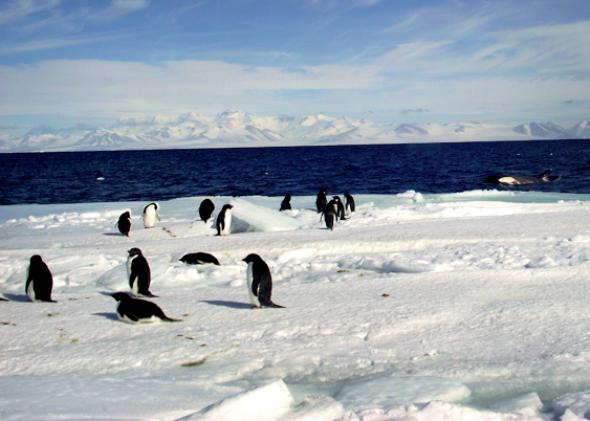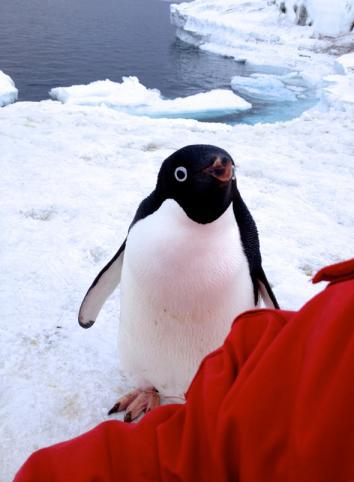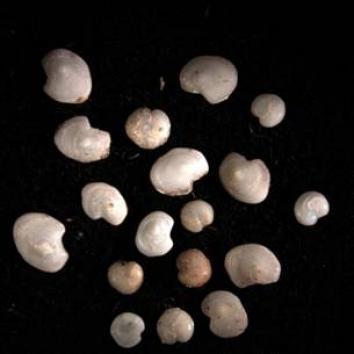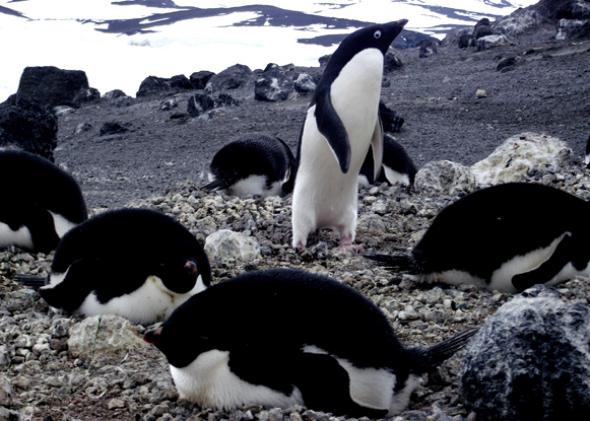To get to the Cape Royds penguin colony, home to several thousand googly-eyed Adélie penguins, you can either make the bone-chilling two-hour snowmobile drive over the sea ice from McMurdo Station, or if weather and winds permit, zip over in 10 minutes by helicopter. Either way, you’ll pass hundreds of seals sprawled slug-like on the ice; pass through the shadow of the volcano Mount Erebus, hunched and smoking; and if you’re lucky, spot an elegant snow petrel gliding by. Jutting off the lava-rock-black Ross Island is your destination: a small peninsula teeming with penguins, the ground of which, oddly, is a uniform dirty white. When I asked Jean Pennycook, penguin educator and researcher, if the soil composition here differs from the rest of the continent, she began to laugh and bluntly clarified what we were standing on: “This would be about 4 to 8 feet of frozen penguin guano.”

Courtesy of Jynne Dilling Martin
Pennycook is the Mary Poppins of the penguins: She chats with them fondly as she moves protectively among them, her curly red hair waving in the wind; she is quick to spot visiting Emperor penguins, first to hear the “phwooosh” of whales spouting, and hops lightly rock to rock with grace and ease to check on nests. She runs an enormously popular penguin education website for teachers, mails thousands of children’s hand-crafted penguin postcards back postage-stamped from Antarctica, Skypes with classrooms (most common question: “Where do you pee and poop?” and her all-time favorite, “Where do you get bacon?”), and flies a different elementary school flag each week at the Cape Royds colony, so that kids back in Cleveland or Dallas or Seattle can tune into her penguin webcam and see their flag flapping merrily above the colony.
“Penguin researcher” may be the fantasy career of millions of children, but the reality of life at the Cape Royds colony is spartan, ammonia-scented, and sometimes brutally cold—storms with 70 mph wind gusts are not uncommon. I helped Pennycook and Katie Dugger, a U.S. Geological Survey scientist from Oregon State University, set up this year’s camp, which involved pitching tents, unpacking pallets of canned beans and Nabisco cookies (granted, unlimited Fudge Stripes is awesome at any age), and digging a hole in the snow to bury the cooler. To answer the most common question: They go to the bathroom in buckets. They melt ice to make water, use solar panels for power, and cook over a Coleman camp stove. And if living in a tent in the Antarctic cold for a few months isn’t tough enough, some of their research work involves the nonglamorous task of examining the vomit and poop of the penguins, which is the least intrusive way to understand what the Adélies are (or aren’t) eating.

Courtesy of Cole Kelleher
This is not to say that Cape Royds is without romance: In fact, it’s the most extraordinary and beautiful place I’ve ever been. My first day at Royds, a pod of about 10 orca whales began jumping and playing and diving right at the ice edge; the Adélies ran amok all around us, shrieking each time a whale surfaced, then curiously peering over the edge to see where it had disappeared to; several Emperors glided majestically about; the seals lazed in the sun; and Erebus sent plumes of smoke into the blue sky above.

Courtesy of Jynne Dilling Martin
It was nature at her most beautiful and exuberant, and I was one of only three humans there to witness it. In my few days living at Royds, I spent hours just sitting in the colony watching the wildly expressive Adélies toddle around me: squawking at skuas, stealing one another’s nest rocks, mates dancing an elaborate choreography before trading off an egg. It’s an extraordinary privilege that, as Pennycook puts it, “they grant us entrance to their kingdom” and don’t object to humans walking in their midst; if you sit quietly enough, they will even come up to tug at your shoelaces and give inquisitive googly-eyed stares.
Penguins rank with koalas and pandas as the most adorable and beloved animals on Earth, inspiring cartoons, books, songs, animated films, documentaries, stuffed animals, and many a childhood obsession (my own included). No one in his or her right mind would ever want to harm a penguin. Yet while slathering love on the penguins themselves, we’ve blithely ignored the environmental factors essential to their long-term survival—most of all, their food. Commercial harvesting of krill and toothfish (marketed to Americans as the more appealing-sounding Chilean sea bass) has abruptly affected major sources of the penguin diet. Attempts to protect the Ross Sea from commercial fishing have repeatedly and astoundingly failed, once again as recently as this past November. The proposal to protect this tiny, ecologically vital, and nutrient-rich part of the ocean is what Dugger calls “a total no-brainer,” yet industrial fishing interests continue to override common sense, and the international alliance that regulates conservation here once again could not reach an agreement.
As part of an international, National Science Foundation–funded research team, Dugger, Pennycook, and their colleagues are passionate about protecting Antarctic wildlife; they particularly worry about the cascading effect of removing so many toothfish from the delicate Ross Sea ecosystem. Adult toothfish, weighing in at roughly 20 pounds, are in the middle of a limited polar food web that includes whales, penguins, squid, and seals fanning in one direction, and smaller prey like the silverfish, krill, and phytoplankton in the other. By annihilating this middle anchor, the Antarctic predator-prey relationships have been thrown into disarray, and all these animals—penguins included—must drastically adapt their diets.

Courtesy of Jean Pennycook
Dugger heated up some frozen chili rellenos in our small tent at Cape Royds while Pennycook explained why she’s been dissecting so much penguin poop. Silverfish, historically part of the penguin diet, each have a signature earbone called an otolith that shows up in penguin guano. The silverfish otoliths are so small they often must be found using a microscope, and they’re ringed like a tree trunk, which allows scientists to determine the age of the silverfish eaten by the penguins and better understand the impact the toothfish harvest is having on the entire food chain. Over blackberry-tinis (frozen blackberries double as fruit flavoring and ice in a healthy shot of gin), I could feel Pennycook’s frustration at pulling apart penguin guano and piling up these tiny otoliths to try to defend a species—in the face of multinational commercial fishing interests; an impotent international organization; and an indifferent, distracted, Chilean sea bass–eating public.

Courtesy of Jean Pennycook
That same night Dugger received an anxious email from her husband, home in Oregon: Worried about how the hummingbirds would fare in a sudden Pacific Northwest cold snap, he had run around their backyard putting beer koozies over their feeders. We all laughed, but I was also very touched by this tender effort. Most of us spend our lives ignoring how our fate is intertwined with that of every other species on Earth, but it’s at the forefront of Dugger and Pennycook’s minds each day, as they watch this year’s Adélies burping up far less pink krill vomit than they have observed at this time of year in the past. Too soon for a firm scientific conclusion, they simply raise eyebrows at each other in silent concern and go back to making daily detailed notes.
Read Jynne Dilling Martin’s first dispatch from Antarctica, about the gorgeous and bizarre life under the sea ice.
